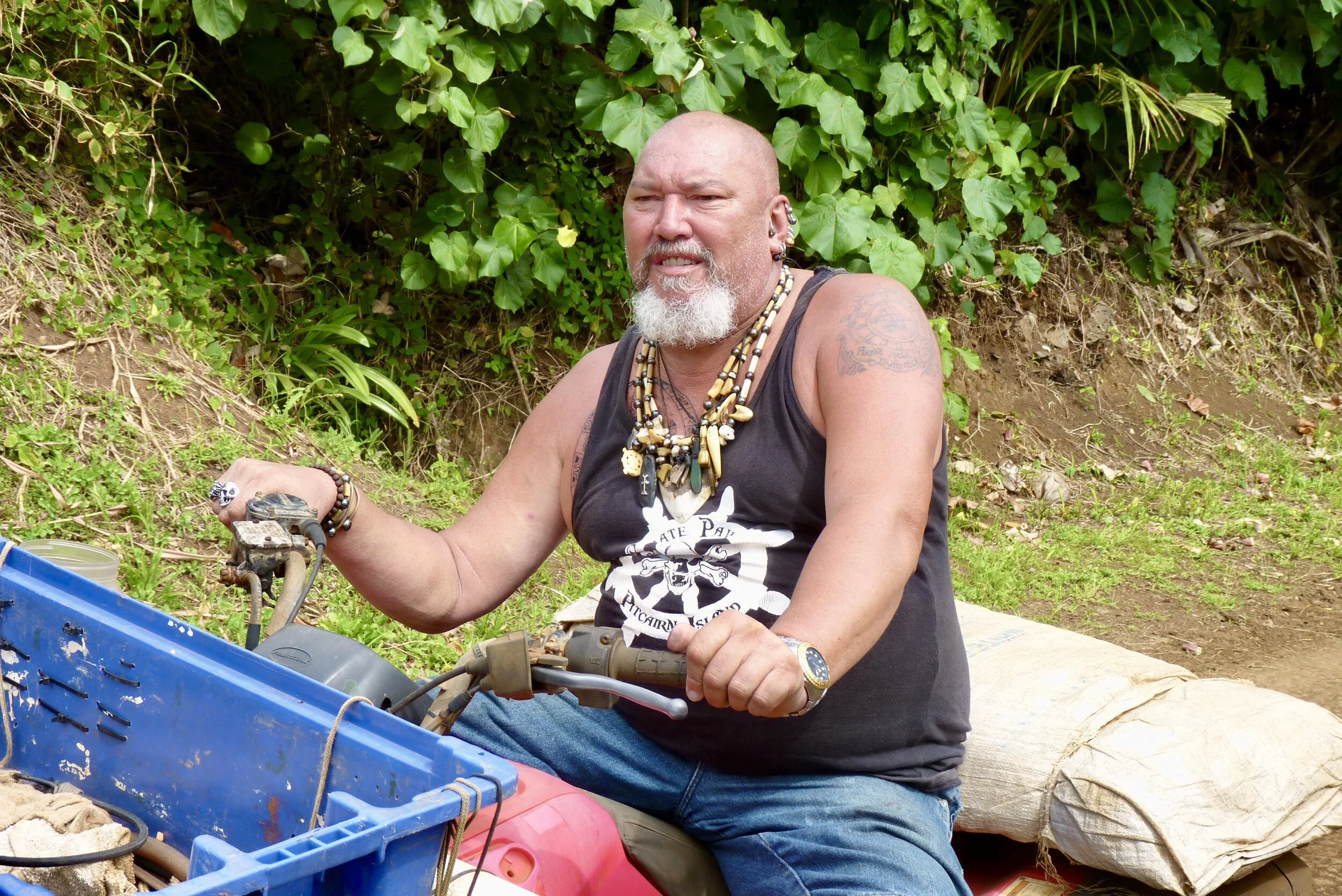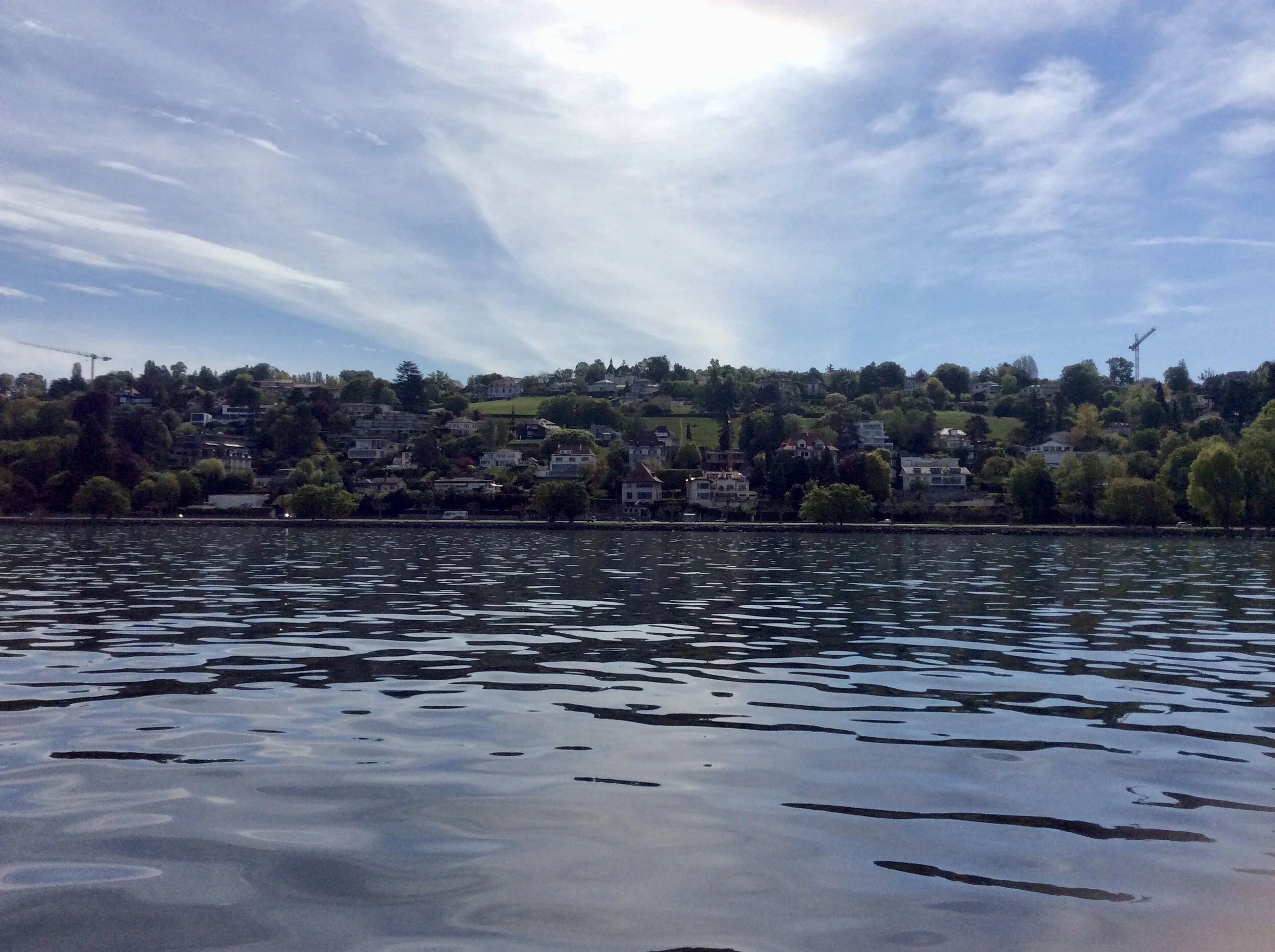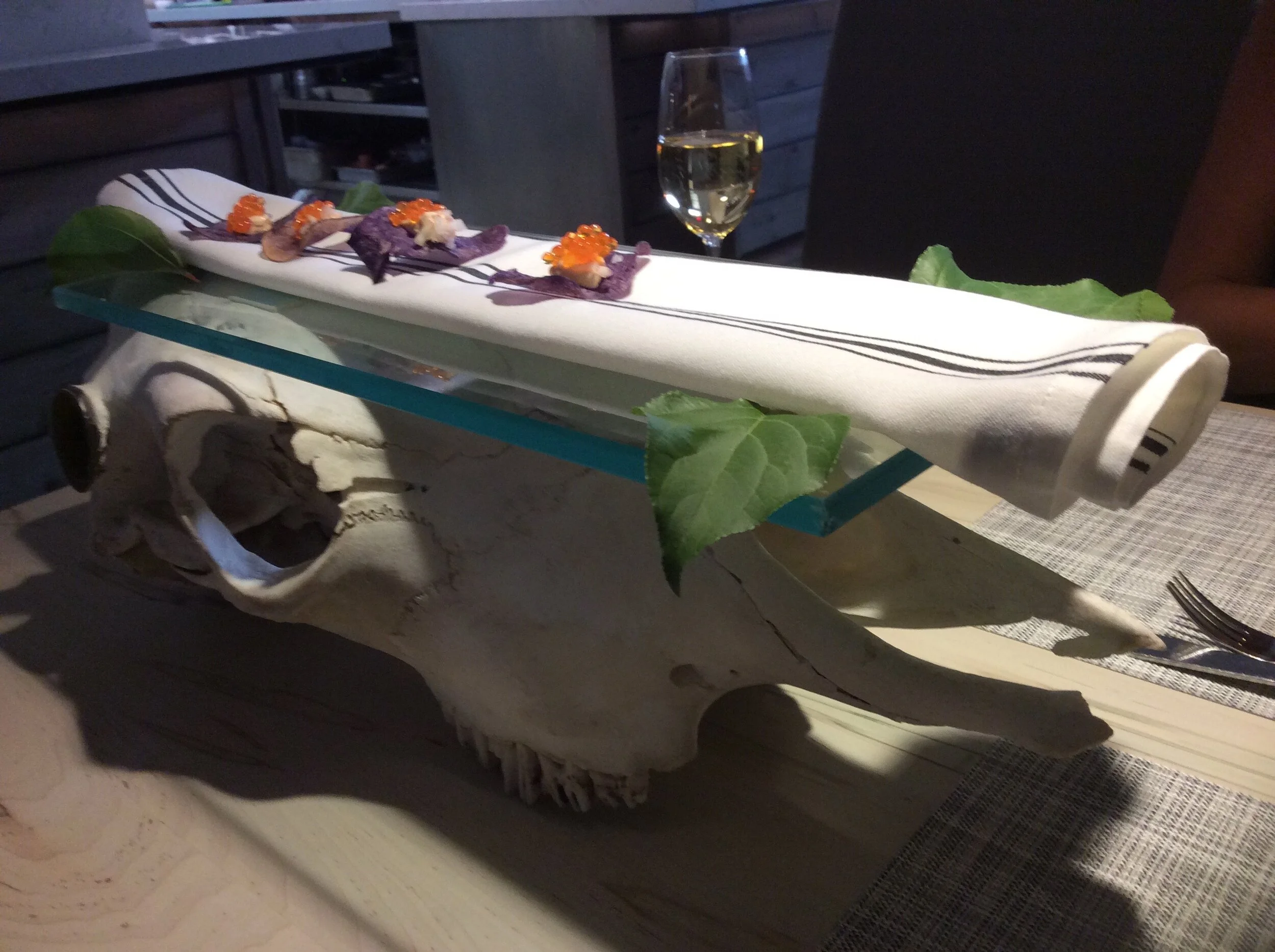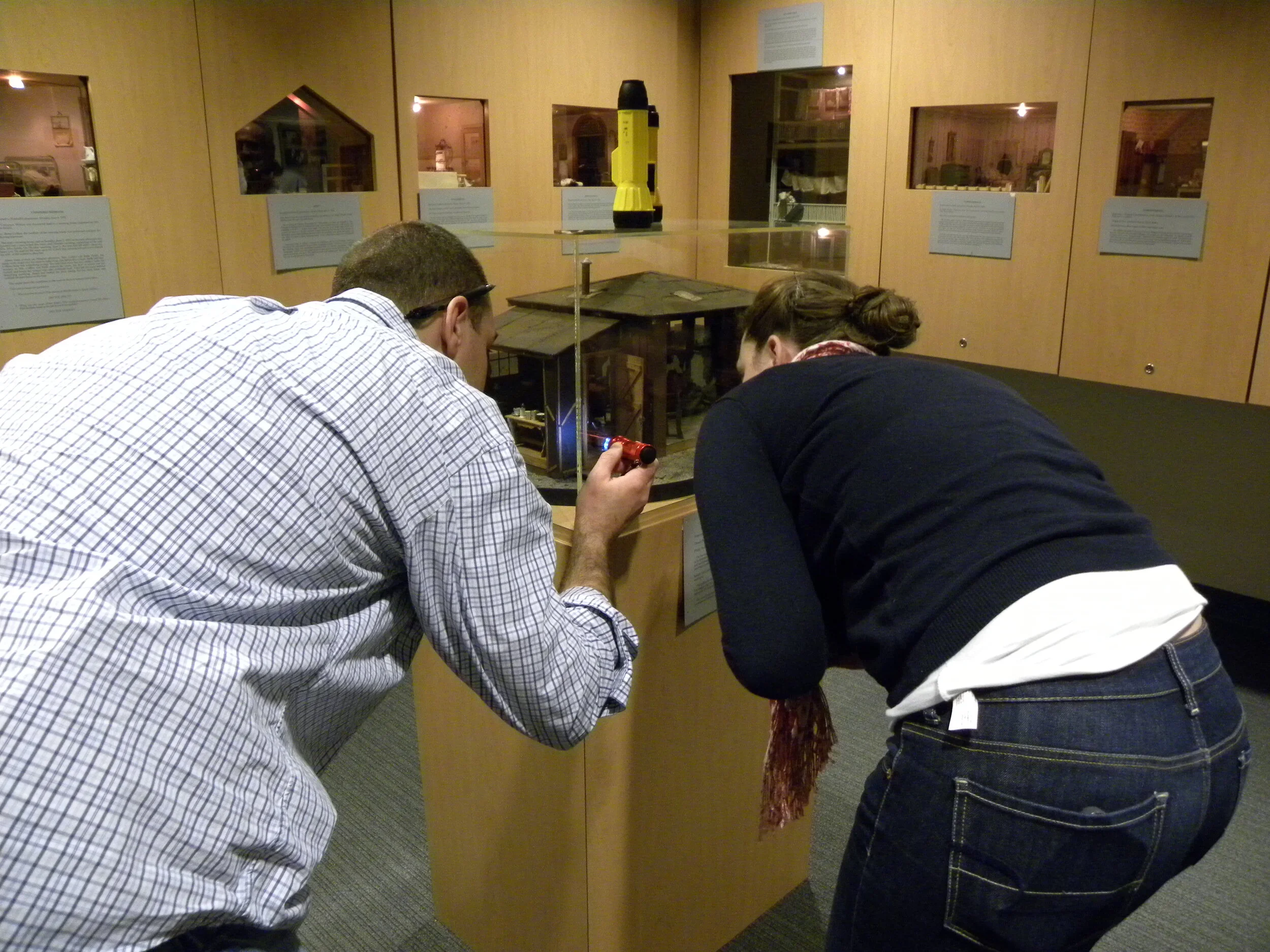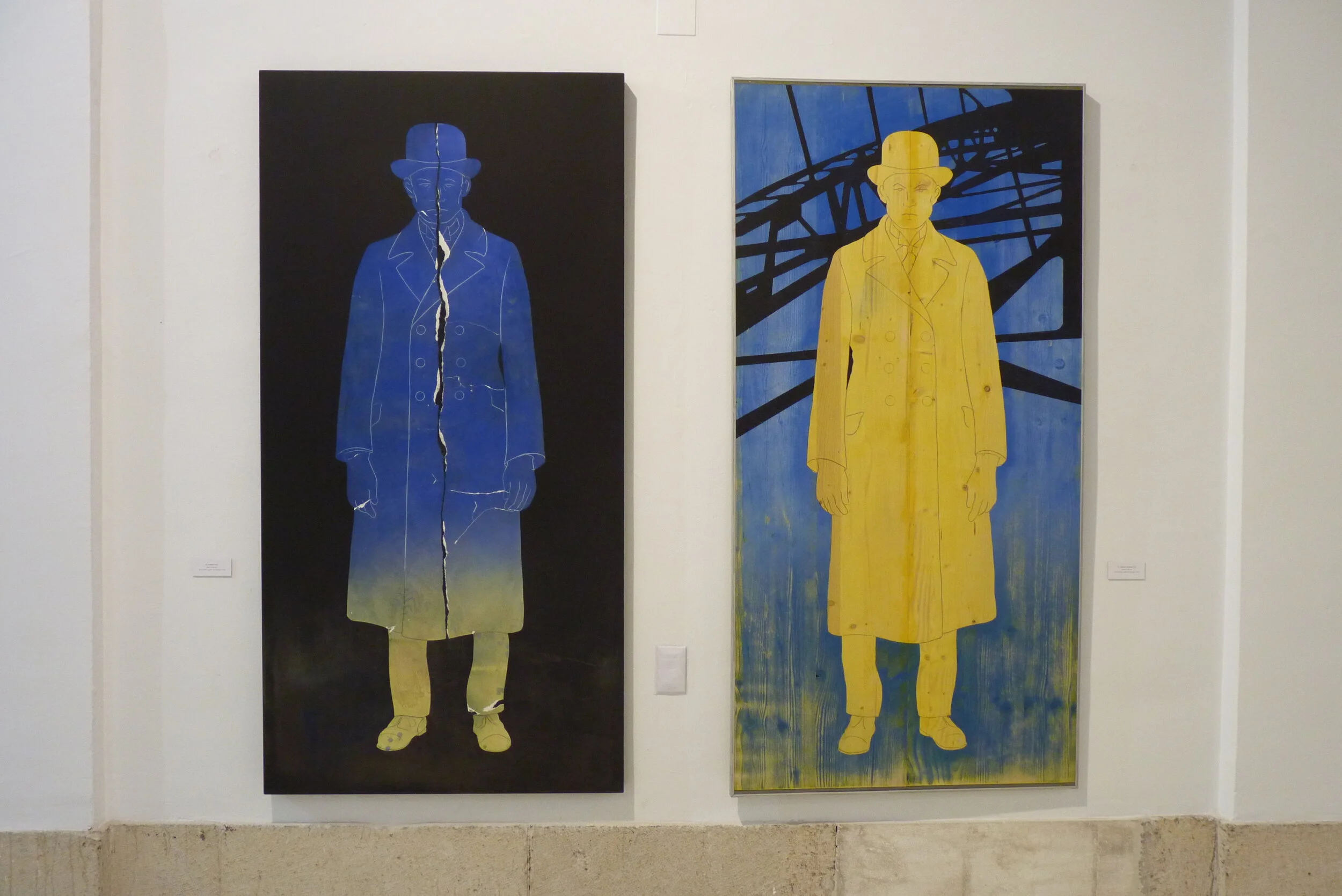A Pitcairn story
Pitcairn Island, the South Seas refuge of the most famous renegades in British history, did not ask to be called a paradise. ‘Hollywood romanticised the whole Mutiny on the Bounty thing,’ said Pawl Warren, the first Pitcairner I met on my recent voyage there, 'but they never followed up what happened afterwards. It became quite bloody, brutal.'
A gentle giant of a man, 56-year-old Warren is directly descended on his mother’s side from Fletcher Christian and Christian’s Tahitian partner, Maimiti. His piratical piercings and tattoos play up to the mutineer image but he is a thoughtful student of his own island backstory, in all its confounding complexities. He was born on Pitcairn, spent nearly three decades in New Zealand and was living back on the island when events took place that have threatened the very existence of the improbable world conjured by his ancestors.
'It’s just another dark page in the history of the island,' he said, referring to the trial and conviction of six Pitcairn men in 2004 for 35 sexual offences against children. Two more men were convicted in 2007 (the youngest of their victims being seven years old) and in 2016 there was an aftershock when an islander was found guilty of possessing hundreds of pornographic images of children. Last November the Pitcairn community attempted to draw a symbolic line under what happened by creating and unveiling a marble 'reconciliation plaque' in the cemetery.
Time to move on, they say. But the storm engendered by these child abuse scandals grumbles on in the place the islanders cannot control, the outside world. And the consequences may yet be terminal. According to one informed observer and critic of Pitcairn, the London-based photographer Rhiannon Adam, it is 'completely on the precipice of extinction'.
This British Overseas Territory (a status it shares with Bermuda, Tristan da Cunha and 11 others) marooned more or less at the midway point in the Pacific Ocean between Australasia and South America is a heck of a place to get to. There is no landing strip. Supply vessels and the occasional cruise ship are its sole lifeline and visitors are consequently few. From Pitcairn’s very inception this lack of contact with the wider human community created a barrier of misunderstanding and suspicion on the part of the islanders that will never be dispelled. I sailed there from Papeete in Tahiti, some 1,200 nautical miles north-west of Pitcairn, on a cargo vessel with passenger cabins called the Aranui 5.
On the five-day passage we followed the approximate route of the Bounty mutineers. They had returned to Tahiti after doing the deed that has hung round their necks ever since, like the albatross in The Rime of the Ancient Mariner. On the morning of April 28 1789, for reasons that remain a matter of conjecture, Fletcher Christian and his fellow renegades took over the Bounty and turfed its captain, Lieutenant William Bligh, and the 18 crew who stayed loyal to him in to the ship’s launch (in this 23-foot-long open boat the much-maligned Bligh masterminded one of the great maritime voyages of survival, across 3,600 miles of open sea to Timor).
Seeking an island sanctuary in which they would never be discovered the mutineers happened on a tiny (two miles by one), uninhabited, steep-sided volcanic rock marked on the charts as 'Pitcairn’s Island'. There were nine mutineers, 11 Tahitian women, six Tahitian men and one child (the women had been effectively kidnapped in Tahiti when Fletcher Christian ordered the Bounty’s anchor cable to be cut after they came aboard for supper). Within a decade all but one (John Adams) of the original mutineers and all of the Tahitian men had died or been killed in acts of mutual bloodletting - the 'bloody, brutal' history referred to by Pawl Warren.
Today’s population retains strong links to the original mutineers - 26 have direct blood lines - and is not much bigger than the first community of 1790. On board the Aranui 5 I met a tenth of Pitcairn’s current inhabitants - that is to say four people, including Pawl Warren, the self-styled pirate of Pitcairn (the many Bounty obsessives aboard were dazzled to meet him) and London-born Leslie Jaques who was Pitcairn’s Commissioner (a UK Government appointment) at the the time of the trial and is now an elected councillor with a brief to represent Pitcairn overseas and develop tourism on the island.
Pitcairn, said Jaques, was an economic 'basket case' when he took over as Commissioner just before the child abuse scandal broke. It had been eking a surplus principally by selling its rare stamps but between 1990 and 2000 revenues plummeted to the point where Pitcairn went bankrupt and needed the mother country to bail her out. Fifteen years on from the trial Pitcairn remains aid-dependent, currently receiving 6 million NZ dollars (about £3 million) annually from DFID (the Department for International Development) and further contributions from the EU’s European Development Fund amounting to more than 7 million euros since 2007. Brexit is likely to leave the island poorer. 'The process that will replace EU funding will be a bidding process in which the little people will probably miss out,' reckoned Jaques.
Aid aside, the principal, related issues affecting Pitcairn’s long-term survival are re-population and employment. The population peaked in the 1930s at about 230 and has been dropping and ageing for the past two decades - a big problem in an environment that makes considerable physical demands of its inhabitants (working the 'longboats' that provide a link to visiting vessels, maintaining roads, operating heavy machinery and so on).
'The current workforce is about 30 which is too low and which means things don't happen and don't get done,' said Jaques. On its website the island administration targets the kind of people 'who enjoy the outdoors, are at home in the natural, unspoilt environment, and would welcome the opportunity to be part of a small but lively community' with the slogan 'Live the Dream … Make the Change… Move to Pitcairn Island'. But there have been few takers. The reputational damage suffered by Pitcairn from 2004 continues to hang over the island.
The first thing you notice about Pitcairn is its air of introversion. Its fortress-like crags and red cliffs are draped in tropical foliage and it has no natural anchorage. Coming ashore is no easy feat in the generally huge swells that buffer the island. There is no Polynesian welcome for new arrivals, no leis round the neck or lilting songs. Bandy-legged men in singlets and shorts waited with quad bikes and battered pick-ups to transport the Aranui passengers from the jetty, up the steep incline known as the Hill of Difficulty, to the main settlement of Adamstown. Mostly European-Polynesian in appearance, islanders speak English to visitors but among themselves some also use a creole known as Pitkern. This is a mash-up of Tahitian and 18th-century English that sounds like fast slang in a Georgian seaport. For 'tomorrow' they say 'On the morrow'. A gun is a 'musket'.
Into this world sailed Rhiannon Adam. In 2015, when she was 29 years old, she disembarked from a cargo ship to spend 96 days here, living with various families, in order to create a photographic record of the island and its people and make a documentary for BBC Radio 4. This summer the Photographers’ Gallery in London will be exhibiting some of her Pitcairn work and in the autumn a book of her photographs and related text will be published. 'I didn’t anticipate that the project would take the turns that it did,' she told me when we met in London. 'My mistake and possibly my only naivety is that I thought they would be wanting change, wanting to right past wrongs.'
Pitcairn is hardly the South Seas paradise of popular imagination There are scarcely any beaches, few long views of the surrounding ocean. Its cliffs and coastal features have names that speak of danger and alarm: Where Tom Fall, Oh Dear, Break im Hip. At its heart is Adamstown, a cluster of buildings that provide the basic needs of a functioning community. There’s a Seventh Day Adventist church (many islanders are teetotal, at least officially), a post office, a public hall, a medical centre, a store, a police station. A ten-minute walk away is the primary school, where the current roll is three (at the age of 13 children go to secondary school in New Zealand).
Scattered across the island among Norfolk Island pines and coconut palms are the 20 or so mostly single-storey wooden houses in which Pitcairners live in an agreeable subtropical climate (winter low 17C, summer high 30C). They catch and eat plenty of fish, tropical fruit and vegetables grow in profusion in the fertile volcanic soil and the island’s famously disease-free bees provide premium honey which they also export. Households are connected to the internet and telephone system via a satellite ink. A new supply ship, the Bravo Supporter, is scheduled to make 21 calls a year from Mangareva in French Polynesia from this year.
For fans of the Mutiny on the Bounty who arrive on cruise and cargo ships there are sites and artefacts to make the trip worthwhile: a rusting Bounty cannon, the ship’s anchor, the grave of John Adams (the whereabouts of the remains of the rest of the mutineers is unknown), various objects in the little museum. Feeding the legend is the islanders’ raison d’être. 'All of their jobs are around playing the part, it is like putting on a Mickey Mouse costume,' said Rhiannon Adam.
Along the 'Main Road' of Adamstown, the day I arrived, islanders had set out curio stalls where they were flogging wood carvings of fish, Bounty-themed T-shirts and first-day covers to the passengers of the Aranui 5. These avatars of legendary men, who advertised their family links to the Bounty by posting up their names and signing their handiwork, chatted happily and posed for photographs. Families can make up to US$10,000 a year from the trade with tourists. But there’s another kind of visitor whose presence they resent.
The 2004 trial and its aftermath not only forced Pitcairn Island to confront dark truths about itself but distilled Pitcairn’s suspicions of the outside world. Whatever internal acrimony there may be, Pitcairners dislike outsiders far more than they dislike each other and will unite against perceived external threats. And nobody poses more of a threat to their sense of who they are than a curious and independent-minded photo-journalist. From the outset, said Adam, she encountered paranoia and hostility. Her three months on Pitcairn would become 'the hardest experience of my whole life'.
The 2004 trial is pretty much a taboo subject. But one of the stallholders I talked to in Adamstown was prepared to discuss it. Mike Lupton-Christian, originally from Ilkley in West Yorkshire, is married to Brenda Christian. 'What was difficult was, she was the island police officer,' he said, referring to the fact that in 2004 Brenda Christian was required to arrest her own brother, the then-mayor Steve Christian (he was subsequently convicted of five rapes). Not being Pitcairn-born, Lupton-Christian managed to avoid inter- and intra-family rancour. 'If it was awkward for me it was only because I was British,' he said.
The UK government made enemies of the Pitcairners over its decision to proceed with the trial, which developed from initial allegations made to a British police officer serving on the island in 1999. There was a view that the mores of faraway Britain did not apply in Polynesia - that consensual sex with girls once they hit puberty is the norm in this part of the world and that nothing more sinister or inappropriate had taken place. The nature of many of the offences does not support this interpretation but the motives and intentions of Her Majesty’s Government are still regarded with suspicion. Many islanders believe Britain is looking for an excuse to wash its hands of this remote and costly anachronism.
The 2004 trial was conducted by three judges from New Zealand in the hall in Adamstown. On October 24 six men were found guilty on 35 counts including child rape and indecent assault. Giving evidence by video link from New Zealand, one of the victims, now middle-aged, said: 'You get abused, you get raped. It's the normal way of life on Pitcairn when I was growing up.' Like many islanders Pawl Warren did not attend the trial. 'I chose not to go and find out who did what to who,' he said. 'At the end of the day, why do I need to know that? I'm not going to judge anybody for what they've done when they've done their time. I still have to work side by side with these guys.'
The men did their time in a prison specially constructed on the island in the run-up to the trial, by some of the very men who were then incarcerated within it. The sentences, extremely lenient considering the severity of the offences, were 'tailored' by the judge to Pitcairn's unique circumstances - if deprived for too long of men of working age the community would have been unable to function. Most offenders were free within two or three years. Stringent child safeguarding practices are now enforced and the official line, underscored by the recent unveiling of the marble mea culpa in the cemetery, is that the trial and jail sentences belong to another era.
Islanders are understandably reluctant to talk about the abuse survivors. Some may still be on the island. Most live among the 5,000-strong Pitcairn diaspora in New Zealand, Australia and elsewhere. One is said to have been placed in a witness protection programme in New Zealand. The text on the 'reconciliation plaque' contains these lines: 'To say we’re sorry does not seek punishment or blame,/ it doesn't say they were right and we were wrong,/ just that we have learnt and understand the error of our ways.'
On the quayside the current mayor Shawn Christian, son of former mayor Steve Christian, sat down with me and talked up Pitcairn’s prospects: 'The future of this island, this whole community, is about a bigger, brighter tomorrow. Because in order to have a successful future and even for attracting migrants, the only way to move forward is to reconcile and I'm really pleased the community did support the initiative [of the plaque].' In 2007 Shawn Christian, now 43, was convicted of gang rape, with his brother Randy, of a 12-year-old girl (he used his shirt to gag his victim). 'The community has moved on,' he told me. 'We just hope the rest of the world has moved on.'
Rhiannon Adam formed a different opinion during her three-month stay in 2015. 'Behind closed doors, if you're there long enough, you start to see the cracks show, to see things fall apart,' she said. 'My own experiences were that their ideas about relationships and sex have not come on very far. I don’t think it’s acceptable that I go to sleep at night and a man decides to enter my bedroom through the window.' This was the second of two related episodes that would define her experience on Pitcairn Island. The man in question, who was 27 at the time, had developed a crush on Adam that started innocently enough but degenerated into inappropriate behaviour. Previously she had found him naked in her bedroom - an incident she described as 'quite terrifying'.
She said the mayor, Shawn Christian, tried to dissuade her from lodging an official complaint with the island police. 'He said, ‘If you do this you're jeopardising our future.’ … It made me realise that if I didn’t say something I was going to be just as bad as the Pitcairn Islanders that allowed this to happen for generations. That someone has to say, ‘You know what, I'm not going to give you a free pass because you’re a Pitcairn Islander, because you’re a special case. For once I'm going to do what I would do if this happened anywhere else in the world’.'
Islanders I spoke to were aware of what had happened to Rhiannon Adam on Pitcairn. One admitted that 'she wasn’t treated very well'. Another dismissed her as 'naive', blaming the incidents on a cultural misunderstanding - few doors on the island have locks and privacy is a relative concept.
Sooner rather than later, believes Rhiannon Adam, Pitcairn will collapse under the weight of its own contradictions. Meanwhile a kind of cognitive dissonance - on the part of the outside world as well as the islanders - helps keep Pitcairn afloat. On my visit I bought some mementoes from the curio stalls set up in Adamstown - two carved fish, proudly signed by men (Steve Christian and Randy Christian) I know to be convicted paedophiles. Through the official island website you can book to stay at the home of Steve Christian for US$150 per person per night.
The decision by islanders to elect Shawn Christian mayor was evidently taken with no consideration for the kind of image or message it projects. 'By allowing him to hold office it’s already saying, ‘Yeah, but the trial wasn't really a big deal was it?’,' said Adam. 'If you really want Pitcairn Island to have a future he should be the one stepping down.' Shawn Christian told me he expected to see the population of Pitcairn double within 20 years, citing the fact that the next day a family of four from the Pitcairn diaspora was moving back to the island and that they had received a settlement application from a young Swedish family.
But Adam is sceptical that repopulation will happen on anything like the scale required: 'Everyone who has left and has experienced life outside can’t imagine themselves back on Pitcairn Island. Those are the people best suited to that kind of life and those people don’t what to go back, so how are you going to persuade anyone else?'
As Pawl Warren said, Pitcairn was never a paradise. Two hundred and thirty years after it was conceived in the disorder of a mutineer’s mind - then idealised in films by the likes of Marlon Brando and Mel Gibson - the experiment sails on through choppy waters, buoyed by its own legend but essentially rudderless. No doubt any islanders reading this will feel justified in their distrust of outside commentators. The conclusion of this commentator is that however fair our criticisms may be we’re all complicit in their plight. 'Pitcairn is a victim of this Empire attitude that we have,' believes Rhiannon Adam. 'We want to keep the Empire, we like this idea of ‘the sun never sets’ but actually when it comes to being responsible for it, and caring for it, we let a lot of places go to the wolves.'
Published in the Telegraph Magazine on May 11, 2019





